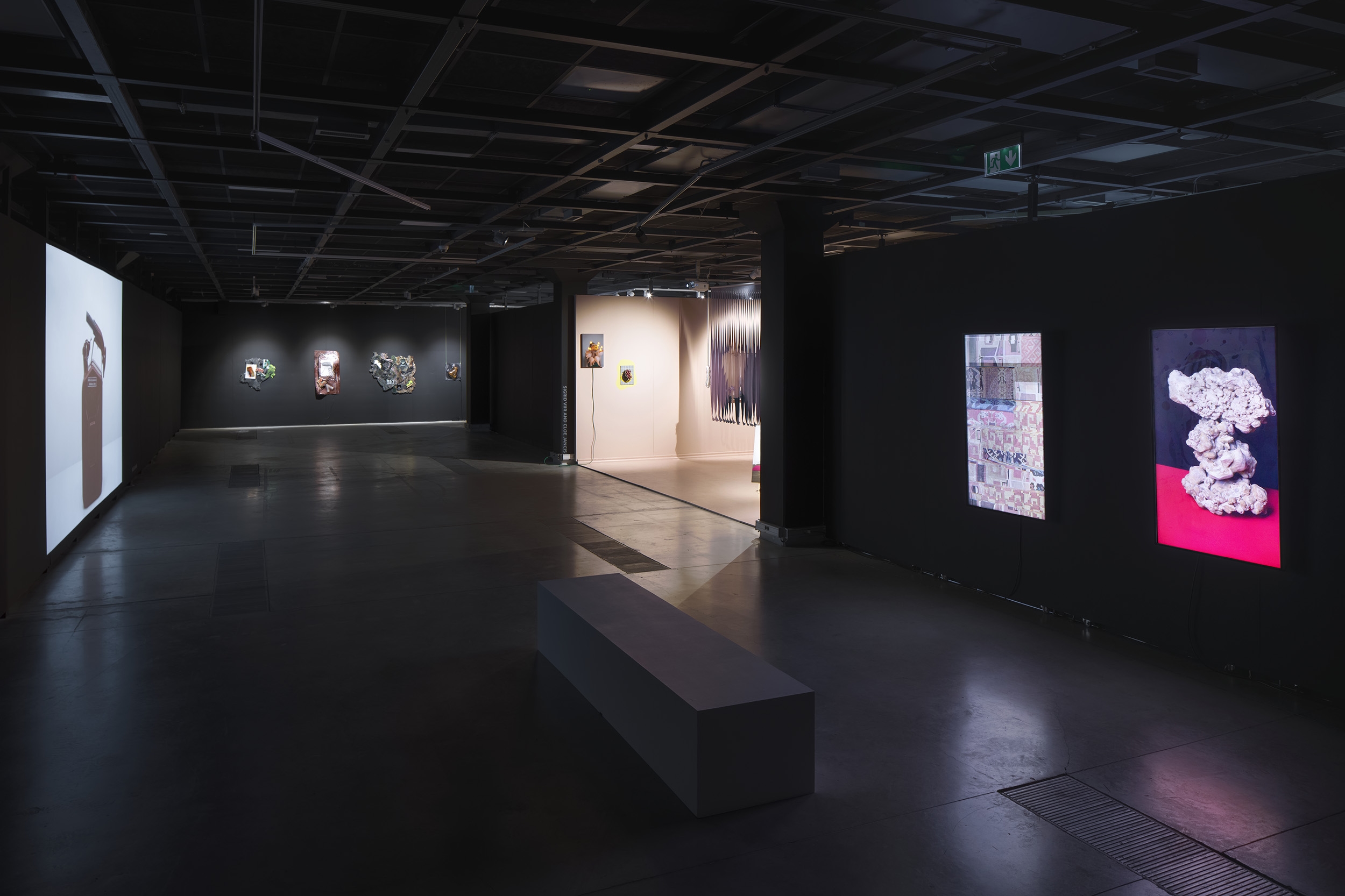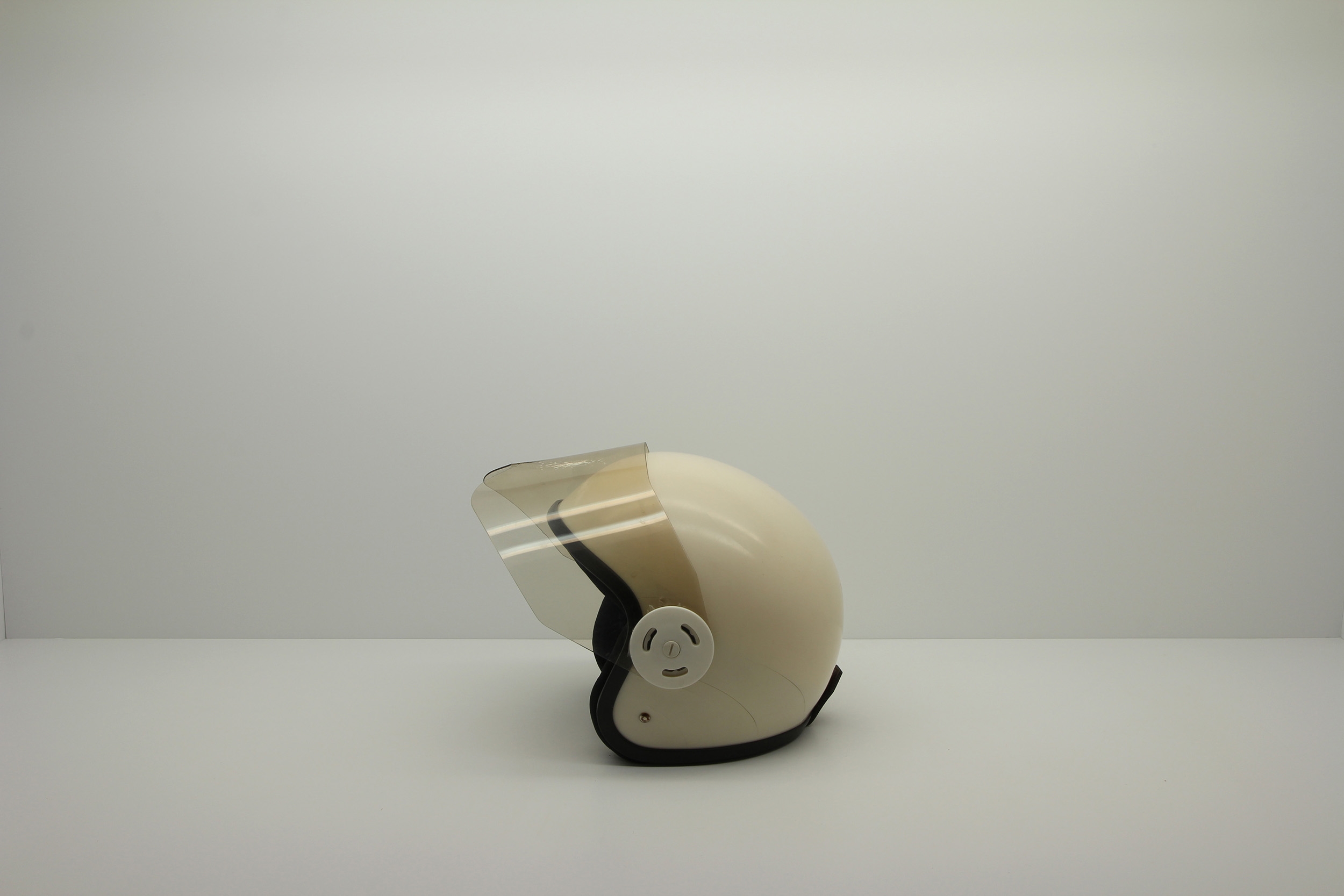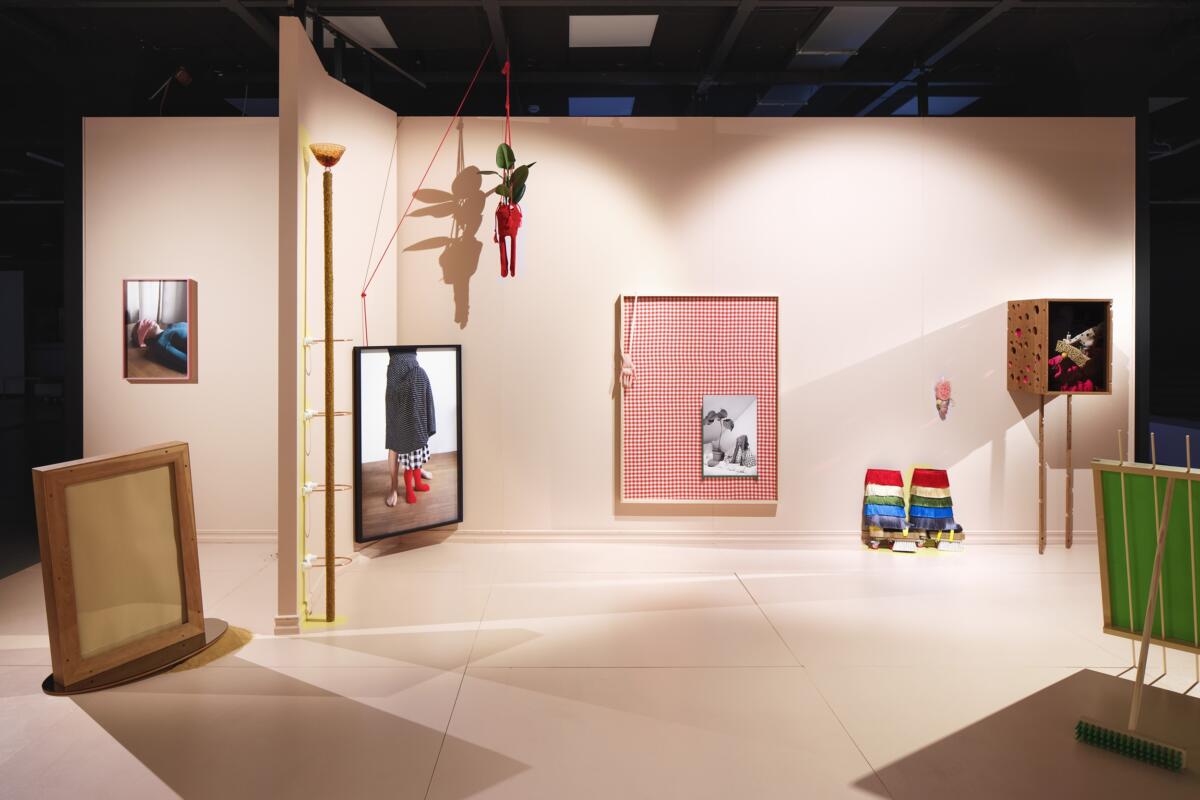
Tytus Szabelski: The main exhibition of this year’s Riga Photography Biennale is Screen Age III: Still Life, which is the third part of the trilogy investigating the influence of technology on society, but also on the medium of photography, and art in general. Marie and Inga, you both curated all three shows, what was your idea behind the series? And what is your aim in touching those subjects?
Inga Brūvere, curator: It started in 2018. The first part of the series was Screen Age I: Portrait. The idea behind it was to focus on the digital and post-human age as well. It surely has a huge influence on our way of thinking, our communication, even aesthetic and so on. It’s also very interesting to me personally, I’m wondering how all of it will develop – perhaps in some 10 years the screen will be the only way we communicate or maybe the situation will change completely. Or it will develop as some kind of parallel reality or so. That is why I have a personal interest in this.
Generally speaking, we wanted to examine this situation. What this digital age really is? Technology impacts us, and it also impacts art – it gives us so many different possibilities to create fictive realities. We came up with the idea for the three parts from the classical art history genres: portrait, landscape, and still life, because for us it’s also a question of heritage, in some way. It’s interesting what we will leave for the next generations. We are still used to this photography we inherited from the 19th and 20th centuries, we know how it worked that time. But what will we give to our descendants? With today’s technology you can produce images that don’t have this relation with reality as before. And the technology is developing all the time, so maybe in 10 years you will not even be able to read this information created now, you know.
And for sure it’s also a question about the development of visual culture. 10 years ago, when I started working with photography, some photographers in Riga told me: “Inga, you don’t know anything about it, it’s not photography what you are showing!” And what is photography? Today it is a part of visual arts. And right now, we’re working as a visual arts event.
And regarding the exhibition itself, honestly, after the second one, Screen Edge II: Landscape, we were not sure if we were going to continue with Still Life. Before COVID I had the impression that artists didn’t work so much with this genre, but when the pandemic started, it changed completely. And then we decided that we will continue, that maybe it was the right time for still life.
Marie Sjøvold, curator: We had a discussion about this when we started working on the third part and at this time we were all isolated in our homes. Our everyday life was so different. I think we all got a new view on the objects we surround ourselves with, and we went into a kind of meditation over those objects. For us it felt like an important theme, the situation of the pandemic actually changed our way of seeing still life. And we wanted to explore that in the exhibition.
And how did you start this series? Did Inga invite you to cooperate, or did you both come up with this idea simultaneously?
Marie Sjøvold, curator: I’m an artist and a photographer myself and I met Inga when she was curating an exhibition that I took part in. Inga invited me to co-curate the first exhibition in the trilogy. I might remember it wrong, but I think she had the vision of the whole trilogy, which I thought were very interesting subjects to work with. Photography and technology and how they’re affecting us today as humans are broad topics, so for each exhibition we had to narrow it down and make a concept inside the bigger concept. The curating took shape from our conversations via Zoom and other technological tools. Finding the artists also happened in quite an unusual way, as during lock down we couldn’t see so many physical shows. So, much of the work curating the last exhibition was actually done through the screen.
Inga Brūvere, curator: But of course, using technology or the internet in our work did not come only as the pandemic started. We had a lot of talking over the internet before, but during the pandemic it helped very much to continue to work.
As I see it, the pandemic was quite an important factor in developing the idea for the latest exhibition and how it was eventually organized. It’s quite evident in the work of Sigrid and and Cloe, because the work itself is a direct result of the pandemic, right? You started cooperating only then, or did you work together before?
Sigrid Viir, artist: With the first wave of the pandemic in Estonia, there was a project organized by the Museum of Photography called Isolation Dialogues, to which different people were invited to collaborate, people with different backgrounds in photography, not only artists, as I remember. And that’s where me and Cloe met or, more precisely, it was Cloe who invited me to participate in a dialogue with her, within this project. But of course, Estonia is so small that we knew each other before, or we knew what we were doing in our art practices. But we had never worked together or even spoken to each other before actually.
The rule was that it had to be only a visual dialogue, so we were not allowed to talk to each other or to discuss what the images are about. We were only allowed to respond with another image. And this is something that we decided to keep on doing with the project, until today – that we are not discussing verbally what the images are about, we are just keeping this visual dialogue.
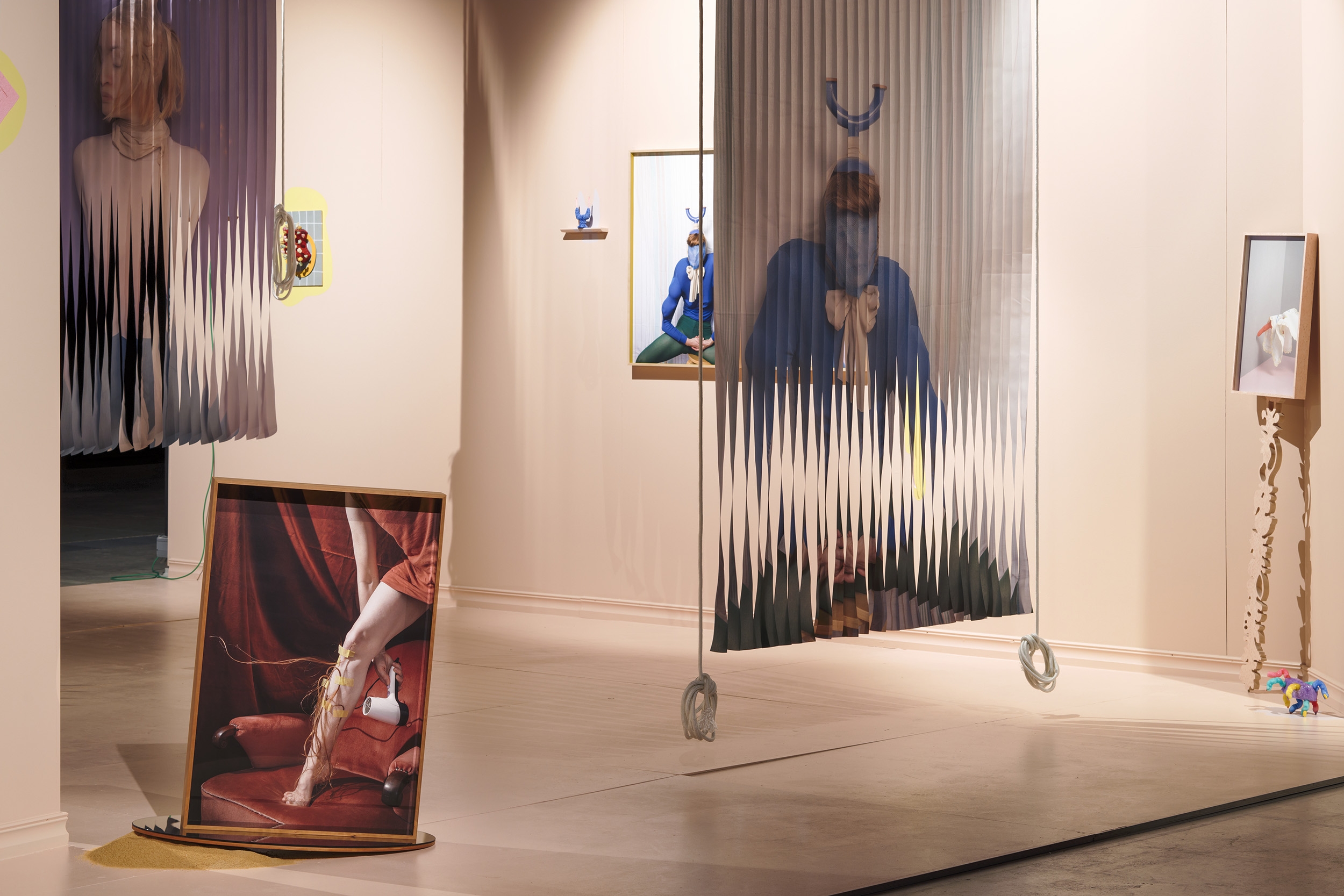
View from the exhibition ‘Screen Age III: Still Life’. Sigrid Viir and Cloe Jancis, ‘In front of the mirror, on a day full of enthusiasm, you put your mask on too heavily, it bites your skin’, 2021. Photo by Ansis Starks
I didn’t know that you were not allowed to talk! And it’s quite surprising because I was impressed by how you managed to achieve such a consistent style of your common work. Style which in my opinion differs from what I can see in your individual works. It’s something more than just a sum of your individual styles.
Krišs Salmanis, artist: I had the same impression. I was totally surprised to hear you talking about the process. I thought that you were partners in art for 20 years or something. My impression of your works is fantastic, and it’s great to learn how they were made. No talking, I like that.
Cloe, so why did you decide to invite Sigrid to cooperate with you?
Cloe Jancis, artist: Previously, when I had seen Sigrid’s work, I felt that it had a dark humor element that I could relate with, I had the feeling that I understood the joke. And when I was invited to the Isolation Dialogues project, I thought that here is the possibility to find out if the feeling was justified. I was curious about what could happen if we started to play together, where this playing would take us. I just had this feeling that there was something to try out.
It’s interesting to me how different your work is, Sigrid and Cloe, from Krišs’ works. But at the same time how similar it is on some level. You not only present the images, but also turn them into objects that we can see at the exhibition as installation. In Krišs’ works presented in the show, installations or objects are photographed or filmed and mediated by the flat image, so it’s the other way round. But at the same time what is similar is this kind of humor or absurdity that I can sense in your both works.
And there is also something that I noticed only now when we were talking – the subject of isolation. Sigrid, Cloe, you created your piece during COVID lockdowns and one of Krišs’ works that are displayed here was created in China, and its subject is the feeling of being isolated in a different cultural environment, and trying to deal with it. Krišs, how do you see the relations between your works?
Krišs Salmanis, artist: Are there relations between our pieces? You mentioned the main thing, which is this slightly twisted sense of humor, which we either try to conceal or we sometimes let break out. And an art exhibition is probably one of the socially acceptable ways of letting it be seen. Also, the use of sticks to present works is common! But that’s a contemporary thing all over now, right?
Was the choice of works for the exhibition yours, or was it the curators’ idea?
Krišs Salmanis, artist: I have nothing to do with it, I just supplied the works that the curators asked for.
Inga Brūvere, curator: It was our choice. Sigrid and Cloe had this communication through the images, not being allowed to talk about them, just exchanging the pictures, and I see something similar also in Krišs works. In some way he also plays with the images, giving them their own value, not mediating it with text, like with 100 Still Lifes. As the curator I see this work a bit directly connected to, let’s say, classical still life genre.
But Krišs, could you elaborate more on the theme of isolation in your other piece and how the work was created?
Krišs Salmanis, artist: The idea for Metro Surfer was basic. I tried to live like the Chinese and I failed, and I found it funny. Instead of taking pictures of how I failed in daily situations, I made little paintings and then put them on sticks and took pictures of those pictures. I’m excited by animation and how much fun you can derive from taking lots of pictures in a row and then, you know, making a tiny loop out of them, and seeing how movement adds so much more to it.
I think my intention was to make an animation and the series of photographs came as a sketch for a possible 12 other animations. I was really lucky to go there. I was interested to see what the aspiring bosses of our future are like in a close up. And all the things that you would expect from China were there, like the excessive surveillance and reliance on digital technologies, even in everyday interactions. When you meet people, they want to take pictures of your phone because there’s a QR code there which tells them everything about you. Even the lady selling potatoes in the street doesn’t have a price tag. She has a QR code. Then you scan it and you have paid her for your dinner.
There are great things about it, like there’s no need to worry about your personal safety in the street because you don’t have any cash with you, and they can’t rob you. They can only take your phone. But well, all of them have phones too, so there’s no point. At the same time every time you buy your potatoes, you send a message to the people who are interested in where visitors from Eastern Europe go in Chengdu.
You’re quite right about the isolation, though. It was three months and I’m not so comfortable with technology. There were artists who used translation applications for making photographs. A Russian artist was pointing the app at things that he found. Not Chinese writing but flowers or buildings. And because it was set up to identify Chinese characters, the application found writing also in things where there was none, so he made a poem out of that, and that was quite nice, actually.
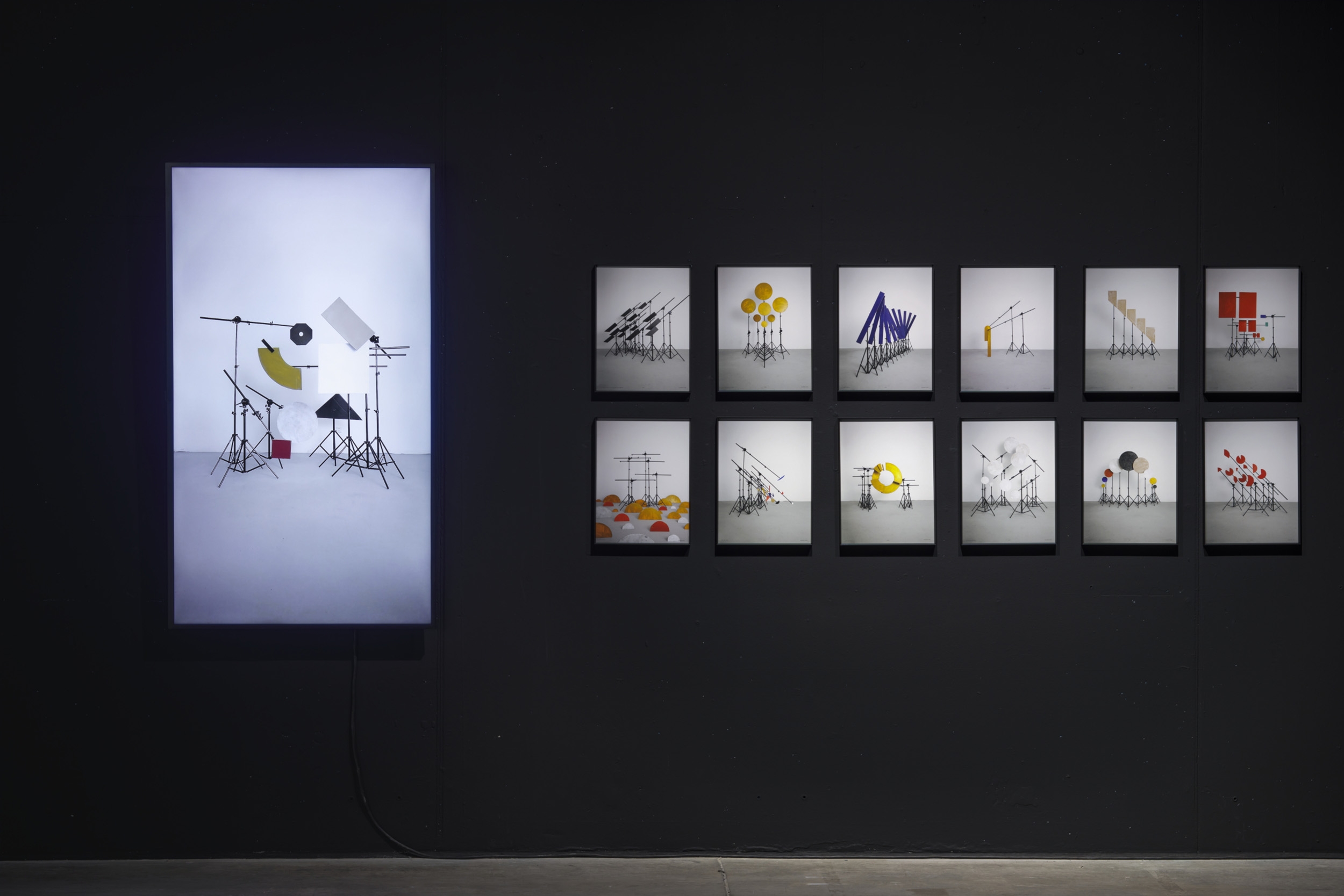
View from the exhibition ‘Screen Age III: Still Life’. Krišs Salmanis, ‘Metro surfer’, 2019. Photo by Ansis Starks
Marie and Inga, I wanted to ask you to come back a little bit to the general questions about the exhibition, and to mention somehow other artworks and other artists that were part of it. Referring to the question of relations between images and objects which seem to me very crucial to the whole concept of this show, how do you see the other artworks positioned in this image-object spectrum? We have Līga Spunde with her, let’s call it a CNC carved digital relief. Or there are Marianne Bjørnmyr’s highly minimalistic photographs of small installations. We have Charles Richardson videos that are based on 3D scans of himself or other people, just to name a few of the artists. How did you put together those different kinds of approaches?
Marie Sjøvold, curator: Well, I think there’s many answers to that, but let’s start with something we already talked about, the theme of isolation, which I think was quite nice that you mentioned, because that’s one thing that I’ve seen in the works of the artists present here today, but also in the works of other artists – Sara Skorgan Teigen for example, with her grief tent. It’s also about another form of isolation, after loss. And you could also see it in Marianne Bjørnmyr’s works, which is an exploration of lost artifacts and cultural deconstruction.
Many of the artists are working with objects, which is a tendency in photography. Artists are going off the walls and into the room. We also want to explore what photography can be today. Some of Marianne’s works have been through a process using 3D printing. Others have used a camera with 3D programs in their process So you can ask is this still photography? It doesn’t really have to do with photography in the way we thought about it before, you know, capturing light. Is it another type of photography or is it photography at all?
Inga Brūvere, curator: Yes, it’s a question of what do we mean when we use the word photography today? Everything is developing and contemporary artists, for example painters, they’re not painting in the impressionist style anymore. They are always looking for some experiments. If we’re talking about this relationship between objects and images – you mentioned Līga Spunde’s work. She made it the opposite way it is usually done with photography. Normally you make the image from the object, but Līga made an object from the image.
In contemporary times, when there are so many possibilities with technology, we cannot talk about just photography anymore, I mean only about photography in this classical way. Maybe we should talk about visual arts, with part of it based on photography? That would refer for example to Krišs’ works. His 100 Still Lifes is based on photography so this is why it’s not photography, but it’s rather part of the visual arts.
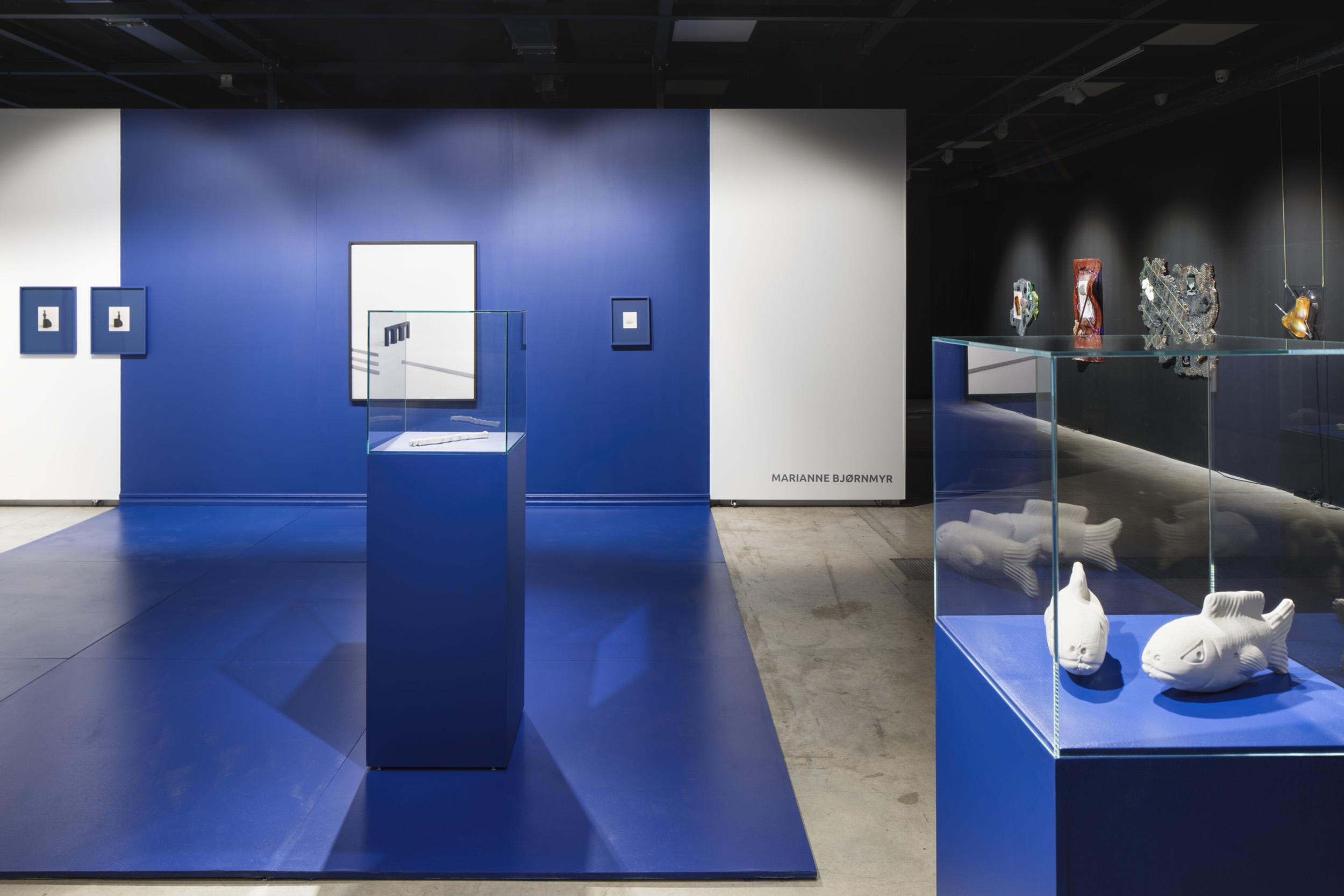
View from the exhibition ‘Screen Age III: Still Life’. Marianne Bjørnmyr, ‘Epitaph’, 2021. Photo by Ansis Starks
From one point of view, it’s nothing very new that we know that images are circulating and they came to us in very different ways and very different forms. It’s like the idea of the post-internet or image-object has already been with us for well more than a decade. But do you think that this is still an important subject of discussion? I mean the circulation of images, different forms that they can take, physical or screen based. Will it be more relevant in the coming years or maybe we will get a little bit tired of this, in our post-pandemic, highly mediated world?
Sigrid Viir, artist: I don’t know, I mean, we haven’t solved those questions yet. And I don’t know what is the next question we are going to ask as artists, or the next thing that is going to come.
Inga Brūvere, curator: It’s quite a normal discussion because our impression about what is photography was completely changed in recent years and that is also a reason why we discuss it. We also have no idea what it will be in the next 5, 10, or 15 years, but perhaps photography will continue to transform, and we will still keep this discussion going.
I was also asking about this particularly because of what I read in the interview with Cloe and Sigrid, which was published in the Biennial catalogue. I think it was Cloe who mentioned that she is kind of tired of this internet mediation and that this is one of the reasons that you both decided to work with this kind of installation.
Cloe Jancis, artist: The main reason why we decided to play with the physicality of the photographs was the limitations of the original online exhibition where our dialogue was presented. They were just pictures on the screen. With the act of giving the image a physical form like a frame , or translating a photo into a sculptural object, we expanded our initial ideas and played with the perception of the photographs.. I was doing installations before, so was Sigrid. It was part of our individual artistic practices beforehand and so the form that our dialogue took in the physical space came to us quite naturally.
When I was talking about becoming tired of images, I was mainly referring to social media and the way in which the platforms flatten and discard meanings behind images. Images are mixed up and shown together in one stream and it leads to this overstimulation and overdrive.. I feel the urge for physicality in art, and in my artistic practice as well. I feel the need to try out the physical possibilities of a photograph, to go back even to the history of photography. I feel that the viewer is also getting used to images being present everywhere.
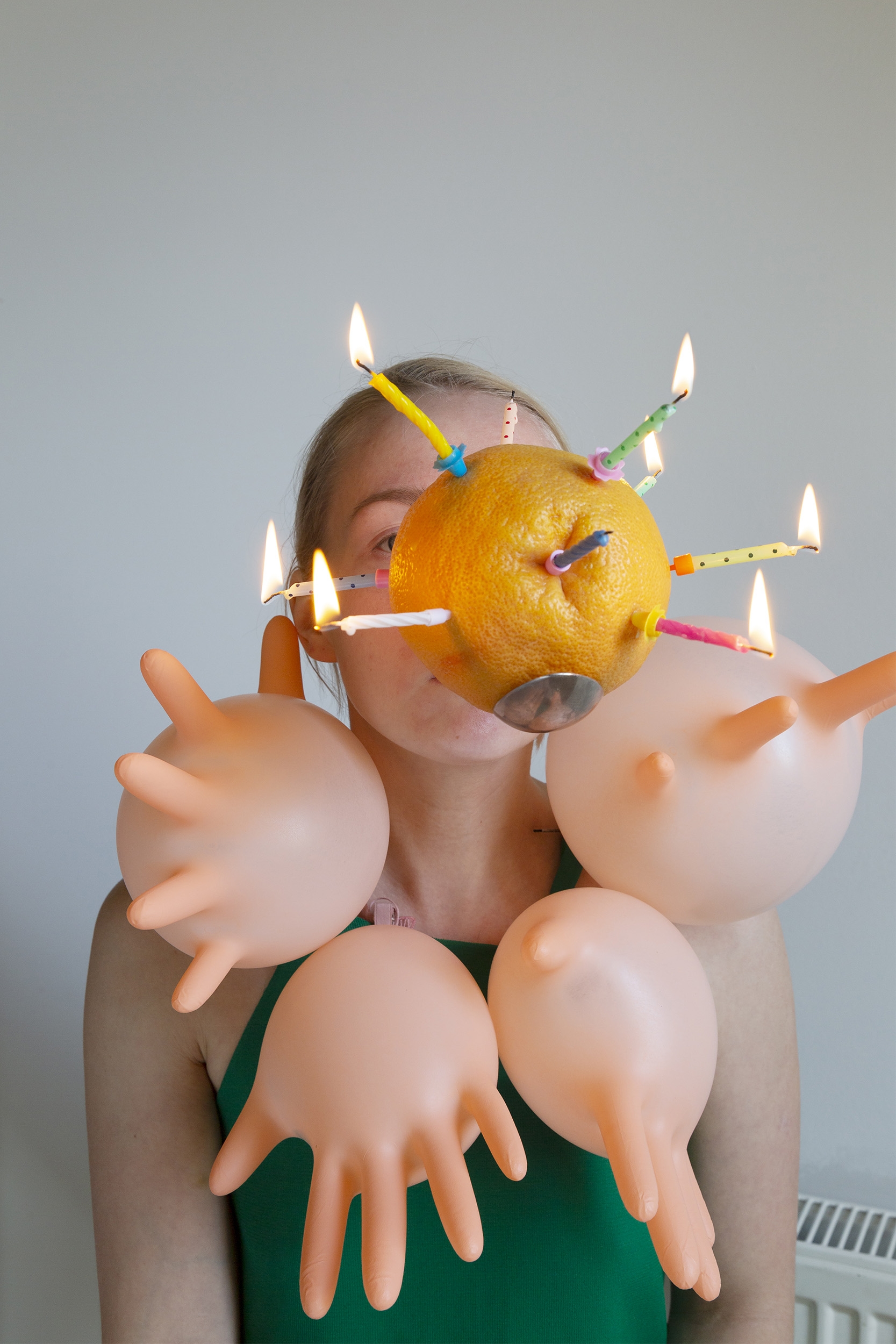
Sigrid Viir and Cloe Jancis, ‘In front of the mirror, on a day full of enthusiasm, you put your mask on too heavily, it bites your skin’, 2021
One other thread coming through your works and the works of the other artists from the exhibition, is performativity. With this I mean several things: in your work, Cloe and Sigrid, you perform by taking images of yourself. In your piece Krišs, there was an awful lot of work with creating stop motion animations. And we can find this also with other artists. So I wanted to ask you, how do you see this performative aspect in your works? Is it important to you or is it just a means to produce something?
Sigrid Viir, artist: We started the project in isolation, and that’s why we also started using ourselves. That was one reason why we were doing it, but I’ve been using myself also before. It’s just so much easier to direct myself. I can’t always say in words exactly what I want to get, but I know it, and I know how to play it out. Sometimes in order to get to the outcome that I want, quite stupid moves need to be played out and I feel much more open to doing it myself and in my studio. I haven’t found this other person who I would feel so comfortable doing it with.
Cloe Jancis, artist: Performativity has always been part of my artistic practice , so it’s not only present in this project, but in other projects before and after. I’m also photographing myself, and while doing that I’m thinking about the performance of the self, both public and private, and how I as an artist transform in front of the camera, playing out these different social roles and expectations. It’s interesting how the autobiographical elements are intertwined with fiction, creating a kind of independent persona that shifts the perception of reality.
Krišs Salmanis, artist: I would only add that I have also used myself in some of my works. Because you can do exactly what you want, and you’re not performing it for somebody else and you’re not acting.It’s also simply cheaper and safer to ask yourself or to do things to yourself, than to expect somebody to let you cut them or run around naked and let them be painted. Or perform in some silly artwork which may not even work in the end. So yeah, it’s an economy of means as well.
Sigrid Viir, artist: And we are always available for ourselves for most of the time.
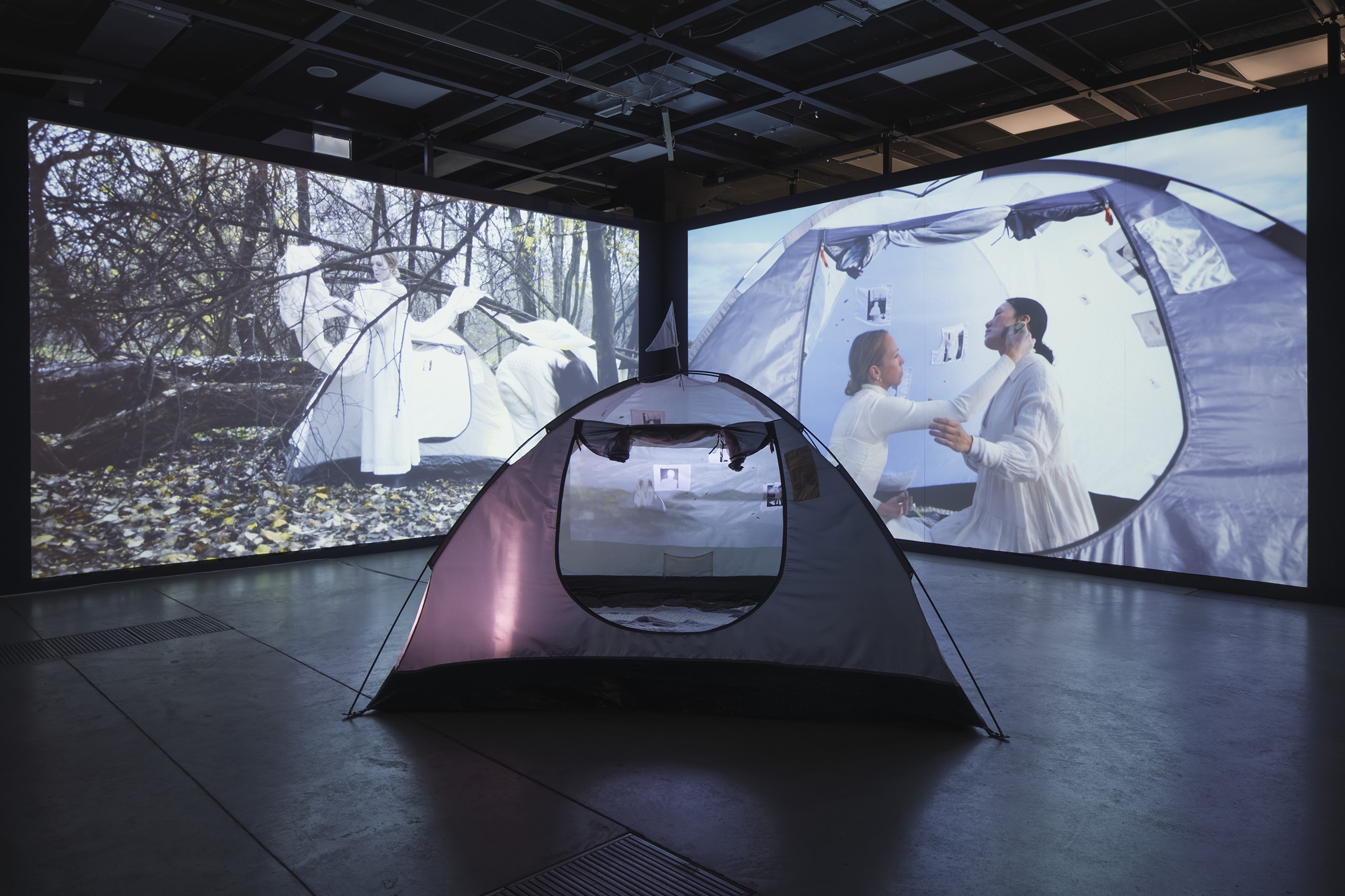
View from the exhibition ‘Screen Age III: Still Life’. Sara Skorgan Teigen, ‘Sharing Tent’, 2020. Photo by Ansis Starks
Krišs, but what about this performativity that is not like, explicitly seen on the screen or in the image. I mean like in a 100 Still Lifes for example.
Krišs Salmanis, artist: I’ve noticed that oftentimes in my work what comes as side effects is more interesting than the actual work itself. And I have never thought about the movements that I make while creating the animation, but that’s a nice thing that you have brought up and I’ll pay attention to it. There’s a dance-like aspect to it, and I’m getting more and more interested in dance. And actually, the piece that’s on view at the moment at the Biennial came about as a long time wish to make an almost abstract dance and animation, and these painted objects were a convenient means of doing that. I have also noticed that the professional animators often move like dancers. They have studied the movements, they know how much pain, how many hours it takes to make just a nice movement of a hand. And sometimes they perform like ballet dancers when they speak about movement.
So maybe the trilogy will continue in the next years with the subject of performativity mediated by the screen? What is the future of this series?
Inga Brūvere, curator: Yes, it’s a good question. We will see if there will be a need for it or if we will get some new direction. We will start to work on the 2024 Biennial this summer. Is there more to look for in this technology age? We will see.
Edited by Ewa Borysiewicz and Katie Zazenski
Imprint
| Artist | Marianne Bjørnmyr, Johan Rosenmunthe, Sara Skorgan Teigen, Sigrid Viir and Cloe Jancis, Charles Richardson, Santa France, Nico Krijno, Līga Spunde, Krišs Salmanis, Vilma Pimenoff |
| Exhibition | Screen Age III: Still Life |
| Place / venue | Riga Art Space |
| Dates | April 22 – June 12 2022 |
| Curated by | Inga Brūvere, Marie Sjøvold |
| Photos | Ansis Starks |
| Website | rpbiennial.com/ |
| Index | Charles Richardson Cloe Jancis Inga Brūvere Johan Rosenmunthe Krišs Salmanis Līga Spunde Marianne Bjørnmyr Marie Sjøvold Nico Krijno Riga Art Space Riga Photography Biennial Santa France Sara Skorgan Teigen Sigrid Viir Vilma Pimenoff |

